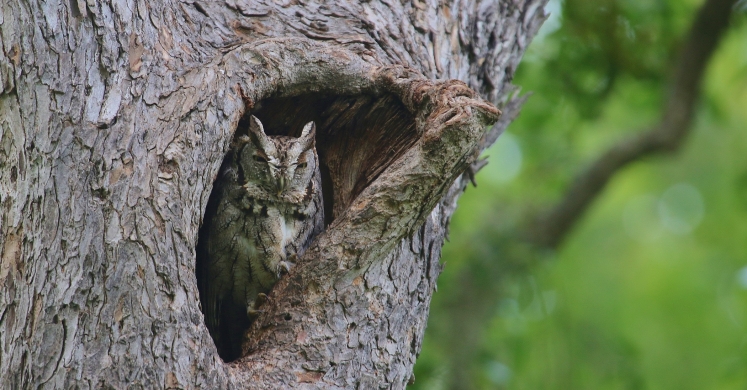Blog

#bioPGH Blog: Owl Prowls
 A resource of Biophilia: Pittsburgh, #bioPGH is a weekly blog and social media series that aims to encourage both children and adults to reconnect with nature and enjoy what each of our distinctive seasons has to offer.
A resource of Biophilia: Pittsburgh, #bioPGH is a weekly blog and social media series that aims to encourage both children and adults to reconnect with nature and enjoy what each of our distinctive seasons has to offer.
We all carried flashlights, but we kept them off until needed. Headlights from the road seemed far away, and after a few minutes, it was amazing how much light the sliver of moon seemed to give off. Even so, I noticed my eyes playing tricks on me in the darkness as they tried to find shapes in the trees. Without my usual vision, my ears picked up the sounds I normally took for granted – the rushing of the water in a stream sounded like great falls, the slightest crack of a twig and scurry of tiny footsteps seemed to echo in the stillness, the crinkling of my jacket when I tugged at my backpack seemed deafening. As we walked through the beautiful night, my fellow birders and I were respectful of the quiet as we listened for the elusive nocturnal creatures that had brought us out to a walking trail in Sarver on this past Saturday night: owls.
Evening owl walks, often affectionately dubbed “owl prowls,” are one of my current favorite excuses to go outside on wintry evening. Usually, an owl prowl involves an easy-paced, guided walk through an area that is known to have owls. Periodically, the group will stop and listen for any owl calls in the area, and the group leader might play a recording of an owl call,* which could lead to a nearby owl responding to the call. There is something enchantingly ethereal about walking through a forest in the dark, and going on these adventures with fellow bird enthusiasts makes the evenings even better.
What might we see on such walks? I reached out to Chris Kubiak, director of education at Audubon Society of Western Pennsylvania, our local chapter of the Audubon, to share about them.
“We have 6 resident owl species [in Pennsylvania],” notes Chris. “The three main owl species we have year round are the Eastern Screech owl, Barred owl, and Great-horned. All three can be found with regularity. The Barn, Short-eared, and Long-eared Owls are much rarer to find but are found in several locations in the state. Northern-saw whet Owls breed in the northern part of the state, but we're not 100% sure they stay all winter so can't really count them as residents.”
This past Saturday on our owl prowl with the Audubon Society, we were looking/listening for the screech, barred, and great-horneds. Admittedly, this particular night, we did not have any luck, but I have heard screech owls and great-horned owls on other owl prowls or Christmas Bird Counts in the past. The magical thing about these evenings, though, is that even if you don’t hear any owls, just the frosty walk under the stars makes the night worth it. The feeling and sounds of a night walk in the woods is a delight for the senses.
And what does Chris enjoy the most about going out late at night and searching for owls?
“My favorite part is having people experience nature at night like all of our ancestors once did, having the owls swoop over top of you.”
Connecting to the Outdoors Tip: You can listen for owls on your own of course, and most of our county parks offer night hikes, which may stumble upon owls even that is not the sole intent. But you can also join enthusiastic owling birders through organized walks with the National Aviary, Hollow Oak Land Trust, North Park, Venture Outdoors, and, of course, Audubon. I personally have attended owl prowls with Hollow Oak and Audubon, and enjoyed them both! If you do attend an owl prowl, here are just a few tips to keep in mind for the evening.
- *If you are on a walk that is calling in the owls with recordings of owl vocalizations, be aware of what time of year it is (avoid owl prowls during breeding season). Also, please do not try to repeat calling in the owls on your own. Improperly done, playing recordings of owl calls can be stressful to the animals. It’s best to leave it to those who have been trained!
- Dress warmly, and be prepared for walking mixed with standing still for extended periods of time.
- Bring a flashlight just in case, but depending on the terrain, most walks will try to acclimate you to the dark. This makes the world around you much easier to see.
- Leave no trace. Whenever you go into a nature area, try to leave no trace of your visit! Stay on the trails to protect the living things of the forest, be sure not to leave any litter, and resist the temptation to bring home “souvenirs.”
- Especially in the dark –safety first! Stay with your group, and be mindful that in the dark, you might not clearly see obstacles around you.
- Most importantly, have fun!
Continue the Conversation: Share your nature discoveries with our community by posting to Twitter and Instagram with hashtag #bioPGH, and R.S.V.P. to attend our next Biophilia: Pittsburgh meeting.
Resources
Photo Credits: cover Gregory SmithCC-BY-SA-2; header, Pexels public domain

